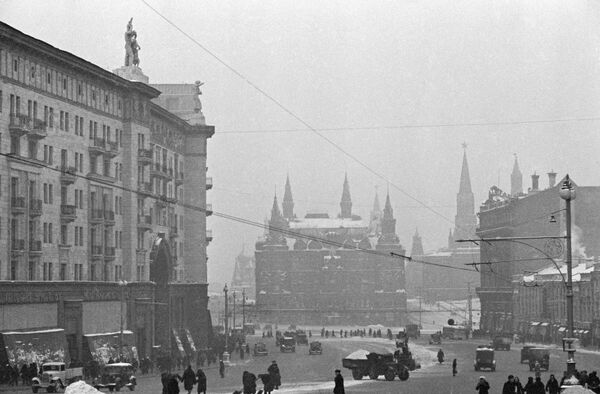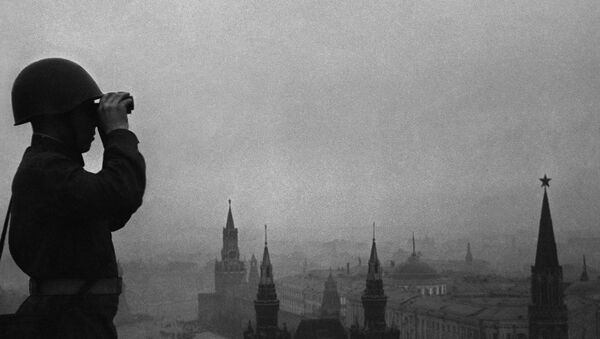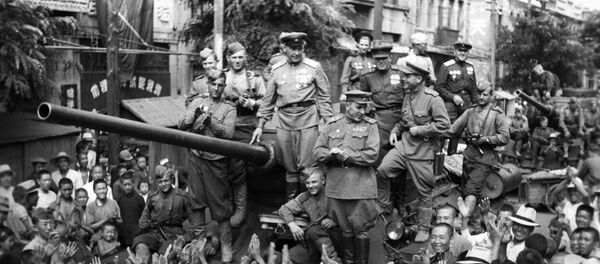This was due not only to the city's successful air defences and the work of Soviet aviation, the Soviet government had another card up their sleeve.
"The issue of camouflaging the Moscow Kremlin was first raised before the war. The Kremlin commander, Nikolai Spiridonov, wrote a note to the Central Committee of the All-Union Communist Party of the Bolsheviks, that is, the highest party organ. It was in May 1939. A similar task was also established in 1941", Sergey Devyatov, advisor to the Director of the Federal Protection Service of the Russian Federation and historian, stated.
On 26 June, a few days after the offensive by Nazi Germany against the USSR began, the Kremlin commander presented his final plan to protect the Kremlin's 28 hectares and buildings to the general commissioner of State Security, Lavrentiy Beria.
The document requested:
- To make it difficult for the enemy to identify the Kremlin;
- To reduce the possibility of dive-bombing on individual buildings of the Kremlin.
The note was accompanied by a draft of the camouflage plan developed by Boris Iofan, an eminent architect of the time, designer of the House on the Embankment and the ideologist behind the “Worker and Kolkhoz Woman” monument.
"Iofan elaborated the possible options to mask the Kremlin. It was his idea to make it completely invisible by merging its vertical structures with the painted fragments that were below them", Sergey Devyatov said.
He explained that "the biggest problems in terms of masking the Kremlin were the tall towers, which are more than 70 metres high, as well as the 82-metre Ivan the Great Bell Tower". Moreover, the triangular shape of the fortress served as an excellent point of reference for the attackers.
The masking works began on 28 June and ended in August, although a decree on measures to camouflage objects in Moscow was made official on 10 July.
"Hundreds of people were involved in the project", Devyatov continued.
The historian clarified that the main work was carried out by military personnel and especially by the Kremlin’s own military regiment.
Boris Iofan’s Brilliant Plan
Iofan’s plan provided two camouflage options:
- Flat simulation: repainting of towers and facades for a visual change from aerial view;
- Volumetric simulation: construction of false structures to protect real objects.
"In the first place, the masking of the Kremlin provided for camouflaging the fortress’ bright elements, such as the ruby stars, which were extinguished and covered with pieces of canvas; the golden domes of Ivan the Great Bell Tower and the cathedrals were also covered. In addition, both the Ivan the Great bell tower, the cathedrals and the buildings were painted in such a way that it seemed that it was not a single building. Streets and avenues were painted on those buildings", Devyatov explained.
The Kremlin's walls and towers were also camouflaged. The towers were stylized "as residential buildings with a large number of windows; streets were painted on the Kremlin walls".
The Nazi bombers at that time could attack the Kremlin from a height of approximately two kilometres, since at a lower height dense anti-aircraft fire awaited them. The bombings occurred mainly at night.
Both types of camouflage gave a good result. This was confirmed by a control observation from a height of 1,000 metres, from different angles.
"In any case, from above, the Kremlin no longer resembled the Kremlin. The triangular design that is familiar to us had ceased to exist", the advisor to the director of the Federal Protection Service said.
Despite the fact that hundreds of people, artists and military, worked to hide the Kremlin, the first bombing, which occurred on the night of 21-22 August, had to be diverted by air defence forces, since the camouflage work wasn’t finished yet. A 250-kilo demolition bomb, filled with ammonia, went through the roof of the Grand Kremlin Palace and fell into St. George's Hall. However, a miracle happened: the bomb didn’t explode. Stuck in the attic, the bomb changed its trajectory, formed a funnel in the ground and fell apart.
Parade on 7 November 1941
"In the place of Lenin’s mausoleum, a two-story mezzanine house was built, imitating 19th-century buildings, made of wood and plywood. In Red Square, several low-rise buildings that mimicked the roofs of residential buildings or warehouses were constructed", the Federal Protection Service advisor said.
Lenin’s body was taken from the mausoleum on 3 July 1941 and returned in 1945. The mausoleum was camouflaged for almost the entire war.
Fake buildings in Red Square were taken down only once during the war. It was for the parade on 7 November 1941. Despite the great risk, Stalin decided not to cancel the parade. According to him, “even the weather helped the Bolsheviks". The festive event coincided with weather conditions unfit for flying.
The dismantling of the imitation buildings was done in one day. After the parade, it took only 24 hours to restore the camouflage.
"In one day, the house that covered the mausoleum and the bleachers was dismantled; at the same time, three false constructions that were in the centre of Red Square were dismantled. Immediately after the parade, they were all put back in their place. The next day, it was reported that the camouflage had been completely restored", Devyatov said.
Moscow Camouflage
During the war, not only the Kremlin and nearby buildings were camouflaged, but also other objects visible from the air. One of them was the diversion channel of the Moscow River, created in the 18th century one kilometre from the fortress to protect it from flooding.
"It was decided to transform the channel with barges and draw streets and houses on them", Devyatov explained.
In addition to the centre of the capital, without a doubt, the strategically important targets of the Nazi bombings were plants and factories.

There, the false construction technique also proved successful, architect Konstantin Markus, son of Boris Markus, commissioner of the student camouflage battalion based at the Moscow University of Architecture, said.
"An absolutely wonderful story was when the boys invented fake factories. In the garbage-covered territories of the state bearing plant they imitated buildings with garden lamps, pitched roofs of plywood, wood, etc… and, as if by chance, unmasking these volumes, they left a little light there. During the first bombing, which happened exactly one month later, on the night of 22 July, these fake factories were bombed, but the bearing plant remained intact", Markus said.
Although the intense attacks on Moscow lasted until April 1942, the Kremlin's camouflage was removed only at the end of the war in 1945. While removing the camouflage, it turned out that the dark paint that covered the domes of the Kremlin's cathedrals had set, and regaining their original shine cost the restorers a lot of time and effort. These efforts, however, cannot be compared to the feat of having preserved the heart of Moscow.





